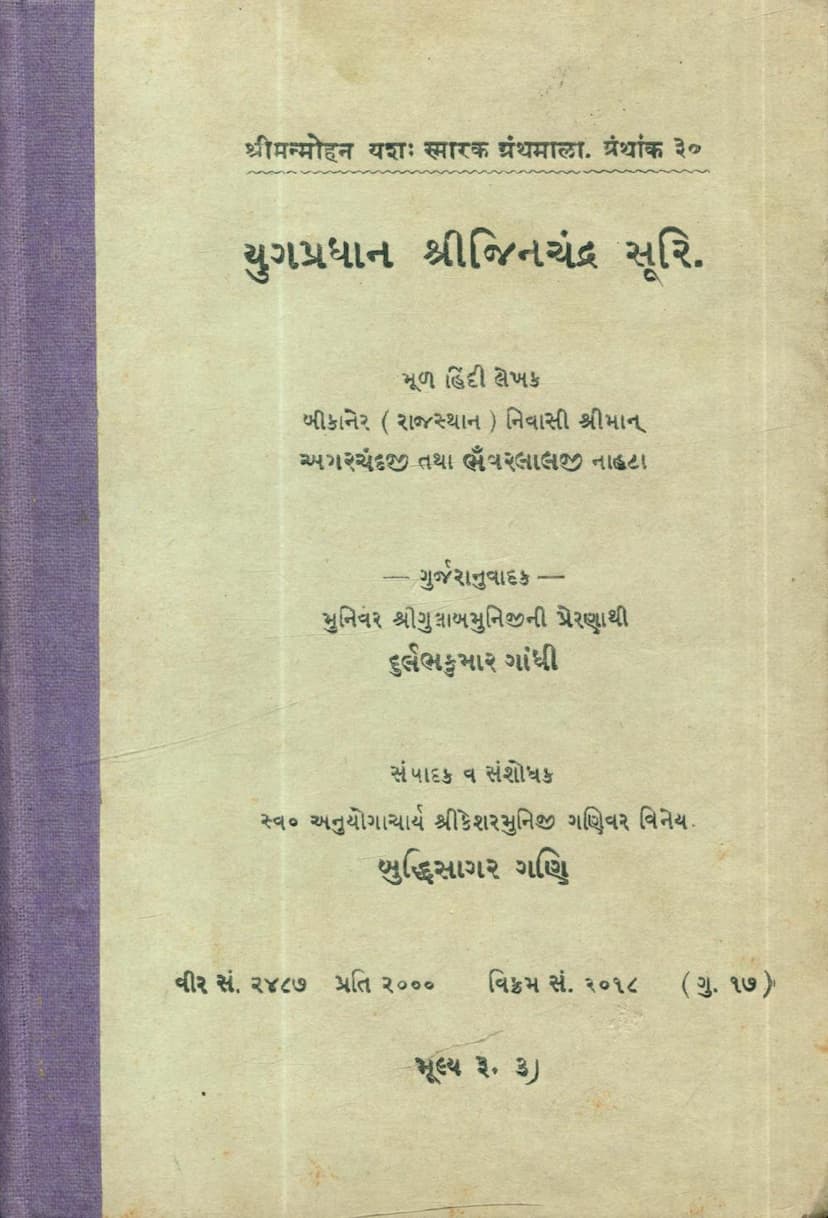Yugpradhan Jinchandrasuri
Added to library: September 2, 2025

Summary
This document is the Gujarati translation of a Hindi book titled "Yugpradhan Shri Jinachandrasuri" (યુગપ્રધાન શ્રીજિનચંદ્રસૂરિ). The book was authored by Agarchand Nahta and Bhanvarlal Nahta and published by Paydhuni Mahavirswami Jain Derasar.
Here's a comprehensive summary based on the provided text:
Core Subject: The book is a biography and historical account of Yugpradhan Acharya Shri Jinachandrasuri Maharaj, a prominent Jain monk from the Kharatargachha lineage. It details his life, teachings, significant achievements, and impact on Jainism and broader society, particularly during the Mughal era in India.
Key Figures and Context:
- Shri Jinachandrasuri: The central figure, recognized as a "Yugpradhan" (leader of the era) and a significant spiritual and administrative authority. He was highly influential and commanded respect from even the Mughal emperors.
- Emperor Akbar: The Mughal emperor during Jinachandrasuri's time. The book highlights their interactions, Akbar's respect for Jain principles, and how Jinachandrasuri influenced Akbar's policies regarding animal welfare and religious tolerance.
- Kharatargachha: The Jain sect to which Jinachandrasuri belonged. The text traces the lineage of Acharyas within this tradition, emphasizing their historical interactions with rulers and their contributions to Jainism.
- Other Prominent Figures: The book also mentions other important Jain Acharyas from the Kharatargachha and other traditions (like Tapagachha) who played significant roles in Jain history, such as Jinadattasuri, Jineshwarsuri, Jinakushalsuri, Hiravijayasuri, Jinaprabhusuri, and Jinavallabhasuri.
- Historical Period: The 16th century (Vikram Samvat 16th century onwards) is highlighted as a period of significant religious and cultural activity in India, marked by the influence of Jain Acharyas on rulers like Emperor Akbar.
Key Themes and Content:
-
Life and Teachings of Shri Jinachandrasuri:
- Early Life: Details of his birth, childhood, and renunciation of worldly life.
- Initiation and Education: His journey into monasticism and rigorous study of Jain scriptures.
- Asceticism and Character: Emphasis on his strict adherence to Jain principles, tapasya (penance), and virtuous conduct.
- Intellectual Prowess: His mastery of Jain philosophy, logic, and literature, evidenced by his scholarly debates and prolific writings.
- Leadership and Influence: His role as a spiritual leader, mediating disputes, and guiding his community.
-
Interactions with Emperor Akbar:
- Summoning by Akbar: How Akbar, known for his religious curiosity, heard of Jinachandrasuri's wisdom and invited him to his court in Lahore.
- Dharma Discourse: The significant dialogues and teachings exchanged between Jinachandrasuri and Akbar, where Jinachandrasuri explained Jain principles, particularly Ahimsa (non-violence).
- Influence on Akbar's Policies: The text details how Jinachandrasuri's teachings influenced Akbar to issue edicts promoting animal welfare (Ahimsa) and exempting Jain pilgrimage sites from taxes. The abolition of animal sacrifice on certain days and the prohibition of hunting are highlighted.
- "Yugpradhan" Title: The bestowal of the prestigious title "Yugpradhan" (leader of the era) by Emperor Akbar upon Jinachandrasuri, recognizing his supreme spiritual and societal influence.
- Miraculous Events: Narratives of Jinachandrasuri's yogic powers and miracles, such as influencing the weather, dispelling negative influences, and demonstrating spiritual control, which impressed Akbar and others.
-
Shasan Prabhavana (Influence on Jainism):
- Revival and Reformation: Jinachandrasuri's efforts in reforming the monastic community, reinstating strict adherence to Jain conduct, and combating laxity.
- Establishment of Institutions: His role in establishing and preserving Jain knowledge, including the tradition of prolific scriptural composition and the establishment of libraries.
- Pilgrimage Protection: His successful efforts to secure imperial decrees protecting Jain pilgrimage sites like Shatrunjaya and Girnar from destruction or desecration.
- Dissemination of Jain Philosophy: His extensive travels and discourses that spread Jain teachings across various regions of India, converting numerous individuals and communities to Jainism.
-
Scholarly Contributions and Disciples:
- Literary Works: The book mentions Jinachandrasuri and his disciples authored numerous important Jain texts, commentaries, and devotional songs.
- Vast Disciple Community: The significant number of disciples he initiated and trained, many of whom became influential scholars and leaders themselves, carrying forward his legacy.
-
Historical Context and Sources:
- The book relies on various historical Jain texts, inscriptions, and chronicles ("Pattavelis," "Gahulis," "Rasa," etc.) to reconstruct the life and times of Jinachandrasuri.
- It acknowledges differing historical accounts regarding dates and events, indicating a scholarly approach to historical research.
-
Structure and Content Overview (from Table of Contents):
- Introduction/Foreword: Setting the historical and cultural context of 17th century India and the flourishing state of Jainism.
- Chapters: Covering Jinachandrasuri's lineage, personal life, debates, travels, interactions with Akbar, achievements, passing, disciples, and the patronage of followers.
- Appendices: Including various historical documents, royal decrees (firmans), poems, and lists of scholarly works, providing primary source material.
- Detailed Biographies: A significant portion is dedicated to the life of Munivar Shri Gulab Muni, who inspired the translation, highlighting his own spiritual journey and contributions.
In essence, "Yugpradhan Shri Jinachandrasuri" is a detailed historical and biographical work aiming to illuminate the life and impactful contributions of a pivotal Jain Acharya, showcasing his influence on both spiritual and secular spheres during a significant period of Indian history.